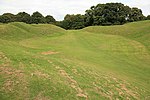Park Leaze Halt railway station
Beeching closures in EnglandCirencesterDisused railway stations in GloucestershirePages with no open date in Infobox stationRailway stations in Great Britain closed in 1964 ... and 3 more
Railway stations in Great Britain opened in 1960Railway stations opened by British RailUse British English from March 2017
Park Leaze Halt railway station was one of two intermediate halts on the Cirencester branch line from Kemble, Gloucestershire, England. It was one of the shortest-lived stations in post-World War II Britain, being open for just over four years, between 1960 and 1964.
Excerpt from the Wikipedia article Park Leaze Halt railway station (License: CC BY-SA 3.0, Authors).Park Leaze Halt railway station
Cotswold District
Geographical coordinates (GPS) Address Nearby Places Show on map
Geographical coordinates (GPS)
| Latitude | Longitude |
|---|---|
| N 51.6875 ° | E -1.9906 ° |
Address
GL7 6PZ Cotswold District
England, United Kingdom
Open on Google Maps







